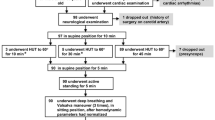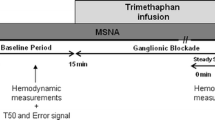Abstract
Autonomic control of blood pressure appears to decline with age giving rise to an increased risk of orthostatic hypotension and major hypotensive reactions to antihypertensive drugs. In the past few years, many workers have assessed autonomic function in the elderly and sometimes found controversial results. Baroreflex sensitivity, as measured by the steepness of the heart rate/mean pressure curve, decreases with age. However, this phenomenon does not correlate well with orthostatic impairment. Sympathetic dysfunction might be more responsible for syncopal symptoms in the elderly, a finding supported by the fact that elderly with orthostatic symptoms never collapse within a few seconds, but do so after 1 or more minutes of standing. However, the results of sympathetic function testing in the elderly indicate that sympathetic function in most elderly is not impaired and that sympathetic activity, as measured by circulating levels of catecholamines, is usually increased rather than decreased.
In various populations with increased sympathetic activity, but not in the elderly, β-adrenoceptor antagonists (β-blockers) have been demonstrated to cause pressor effects, presumably due to α-adrenoceptor-mediated vasoconstriction unopposed by β-receptor-mediated vasodilation. In the past year, large studies have been completed indicating that the same is true for the elderly, and that the depressor effect on pulse pressure upon standing in this category of patients can be offset and turned into a pressor effect by long-term β-blocker treatment. This phenomenon could not be demonstrated with non-β-blocker antihypertensive drugs, including ACE inhibitors, calcium channel antagonists, diuretics and angiotensin II receptor antagonists. In elderly patients β-blockers may, therefore, be the most appropriate antihypertensive agents as they protect the elderly from orthostatic impairment.



Similar content being viewed by others
References
Swales JD, Sever PS, Peart SS. Hypertension in the elderly. In: Swales JD, Sever PS, Peart SS, editors. Clinical atlas of hypertension. London, UK: Gower Medical Publishing, 1991: 6.22–8
Cleophas TJ, Grabowsky I, Niemeyer MG, Nebivolol Follow-up Study Group, et al. Long-term efficacy and safety of nebivolol monotherapy in patients with hypertension. Curr Ther Res 2001; 62: 451–61
Cleophas TJ, Grabowsky I, Niemeijer MG, et al. Paradoxical pressor effects of beta-blockers in standing elderly subjects, a beneficial side-effect. Circulation 2002; 105: 1669–71
Swales JD, Sever PS, Peart SS. Pharmacologic treatment of hypertension, adverse effects and quality of life. In: Swales JD, Sever PS, Peart SS, editors. Clinical atlas of hypertension. London, UK: Gower Medical Publishing, 1991: 10.18–23
Mark AL, Mancia G. Cardiopulmonary baroreflexes in humans. In: Shepherd JT, Abboud FM, editors. Handbook of physiology. Bethesda (MD): American Physiological Society, 1983: 795–813
Tank J, Neuke A, Molle A, et al. Spontaneous baroreflex sensitivity and heart rate are not superior to classic autonomic testing in older patients. Am J Med Sci 2001; 322: 24–30
Cleroux J, Giannattasio C, Bolla GB, et al. Decreased cardiopulmonary reflexes with aging in normotensive humans. Am J Physiol 1989; 257: H961–8
Iwase S, Mano T, Watanabe T, et al. Age related changes of sympathetic outflow to muscles in humans. J Gerontol 1991: 46: M1–5
Ng AV, Callister R, Johnson DG, et al. Age and gender influence muscke sympathetic nerve activity at rest in healthy humans. Hypertension 1993; 21: 498–503
Esler MD, Turner AG, Kaye DM, et al. Aging effects on human sympathetic neural function. Am J Physiol 1995; 268: R278–85
Sundlof G, Wallin BG. Human nerve sympathetic activity at rest: relationship to blood pressure and age. J Physiol (Lond) 1978; 274: 621–37
Yamada Y, Miyajima E, Tochikubo O, et al. Age-related changes in muscle activity in essential hypertension. Hypertension 1989; 13: 870–7
Ebert TJ, Morgan BJ, Barney JA, et al. Effects of aging on baroreflex regulation of sympathetic activity in humans. Am J Physiol 1992; 263: H798–803
Matsukawa T, Gotoh E, Uneda S, et al. Augmented sympathetic nerve activity in response to Stressors in young borderline hypertensive men. Acta Physiol Scand 1991; 141: 157–65
Matsukawa T, Mano T, Gotoh E, et al. Elevated sympathetic nerve activity in patients with accelerated essential hypertension. J Clin Invest 1993; 92: 25–8
Jardine DL, Ikram H, Frampton CM, et al. Autonomic control of vasovagal syncope. Am J Physiol 1998; 274: H2110–5
Rudas L, Kardos A, Simon J. Regulation of immediate blood pressure response to orthostasis in patients with fixed ventricular pacemaker rhythm. Clin Sci 1996; 91: s97–100
Wieling W, Borst C, Van Dongen-Torman MA. Syncope in elderly, shortly after standing. Neth J Med 1985; 129: 157–60
Meeks WM. Pathophysiology of hypertension in the elderly. Semin Nephrol 2002; 22: 65–70
Rutan GH, Hermanson B, Bild DE, CHS Collaborative Research Group, et al. Orthostatic hypotension in older adults: the Cardiovascular Health Study. Hypertens 1992; 19: 508–19
Wesseling KH, Jansen JR, Settels JJ, et al. Computation of aortic flow from pressure in humans using a nonlinear, three-element model. J Appl Physiol 1993; 74: 2566–73
O’Rourke MF. Isolated systolic hypertension, pulse pressure, and arterial stiffness. Curr Hypertens Rep 1999; 3: 204–11
Cleophas TJ, Kauw FH, Bijl C, et al. Effects of beta adrenergic receptor agonists and antagonists in diabetics with symptoms of postural hypotension: a double-blind, placebo-controlled study. Angiology 1986; 37: 855–62
Man In’T Veld AJ, Schalekamp MA. Pindolol in orthostatic hypotension. BMJ 1981; 282: 929–31
Mehlsen J, Stadaeger C, Trap-Jensen J. Differential effects of beta-adrenoceptor partial agonists in patients with postural hypotension. Eur J Clin Pharmacol 1993; 44: 7–11
Hoffman BB, Lefkowitz RJ. Beta receptor antagonists, pharmacological properties. In: Goodman Gilman A, Hardman JG, Limbird LE, et al. editors. The pharmacologic basis of therapeutics. New York: Pergamon Press, 1991: 231–3
Prichard BN, Owens CW. Response to physiological stimuli in patients treated with beta-blockers. In: Kostis JB, De Felice EA, editors. Beta-blockers in the treatment of cardiovascular disease. New York: Raven Press, 1984: 12–3
Morrison SC, Kumana CR, Rudnick KV, et al. Selective and nonselective beta-adrenoceptor blockade in hypertension: responses to changes in posture, cold, and exercise. Circulation 1982; 65: 1171–7
Cleophas TJ, Kauw FH. Pressor responses from beta-blockers. Angiology 1988; 39: 587–96
Shepherd AMM, Lin MS, Keeton TK. Hypoglycemia-induced hypertension in diabetics on metoprolol. Ann Intern Med 1981; 94: 357–8
Bravo EL, Gifford RW. Pheochromocytoma: diagnosis, localization and management. N Engl J Med 1987; 311: 1298–303
Ramoska E, Sachetti AD. Propranolol-induced hypertension in treatment of cocaine-intoxication. Ann Emerg Med 1985; 14: 112–3
Lipsitz LA, Marks ER, Koestner J, et al. Reduced susceptibility to syncope during tilt in old age: is beta-blockade protective? Arch Intern Med 1989; 149: 2709–12
Khattar RS, Swales JD, Dore C, et al. Effect of aging on the prognostic significance of ambulatory systolic, diastolic and pulse pressure in essential hypertension. Circulation 2001; 104(7): 783–9
Hansson L, for the HOT Study Group. The Hypertension Optimal Treatment (HOT) Study, a prospective randomized open blinded end-point study. Lancet 1998; 351: 1755–62
Staessen JA, Fagard R, Thijs L, et al. Randomised double-blind comparison of placebo and active treatment for older patients with isolated hypertension. Lancet 1997; 350: 757–64
Sleight P, Yusuf S, Pogue J, et al. Blood pressure reduction and cardiovascular risk in HOPE Study. Lancet 2001; 358: 2130–1
PROGRESS Collaborative Group. Randomised trial of a perindopril-based blood-pressure-lowering regimen among 6105 individuals with previous stroke or transient ischaemic attack. Lancet 2001; 358: 1033–41
Furberg CD, Psaty BM, Cutler JA. Blood pressure and cardiovascular disease. In: Yusuf S, editor. Evidence-based medicine. London: BMJ Books, 1998: 226–38
Acknowledgements
No sources of funding were used to assist in the preparation of this manuscript. The authors have no conflicts of interest that are directly relevant to the content of this manuscript.
Author information
Authors and Affiliations
Corresponding author
Rights and permissions
About this article
Cite this article
Cleophas, T.J., van Marum, R. Age-Related Decline in Autonomic Control of Blood Pressure. Drugs Aging 20, 313–319 (2003). https://doi.org/10.2165/00002512-200320050-00001
Published:
Issue Date:
DOI: https://doi.org/10.2165/00002512-200320050-00001




